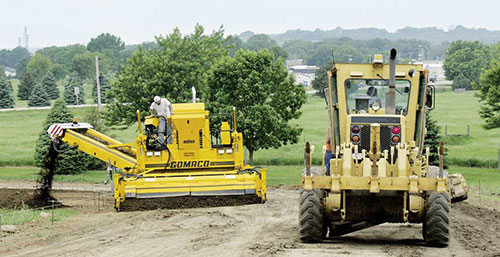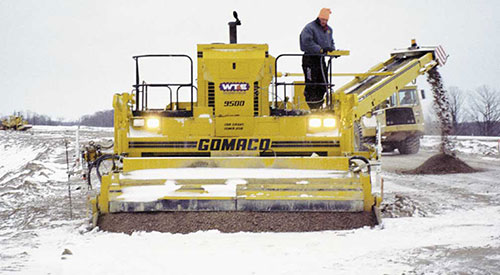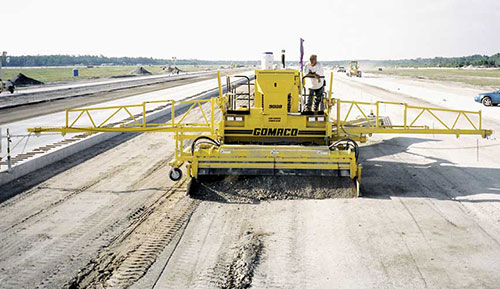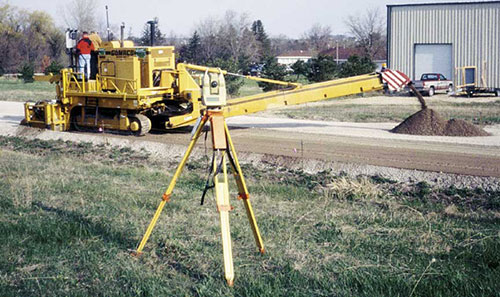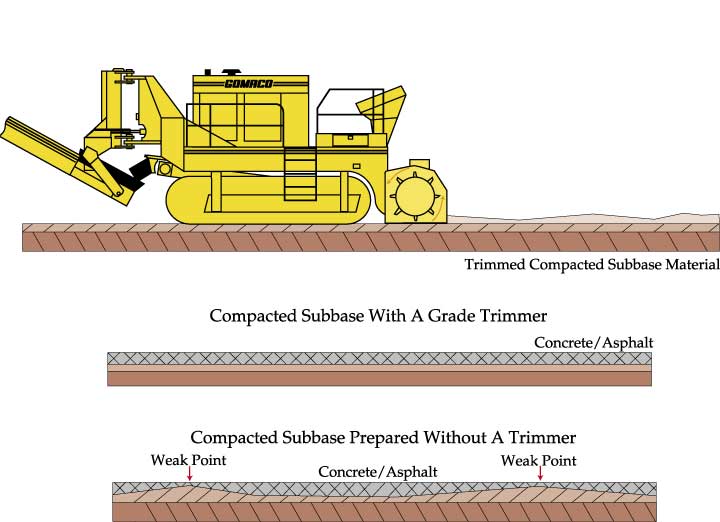GOMACO World Index --- GOMACO World 31.2 - October 2003
Grade Trimmers And Motor Graders
A discussion with Kendall J. Kelly, GOMACO's Southwest District Representative with over 30 years experience in the concrete construction industry
Bridges, buildings, and roadways have one thing in common, for an acceptable final product there must be an excellent foundation. In a roadway, the foundation is the subgrade or subbase. Depending on the geographical area, this may be anything from natural soils with various types of clays or sands, some type of rock or a combination of these.
Variations in Thickness and Density
Engineers usually design the subgrade, or the material directly beneath the concrete or asphalt paving, to perform at an optimum to allow for the longest life of the concrete or asphalt paving. No matter what the composition of the subgrade, it should be of a consistent density and cut to an elevation that is absolutely parallel to the final surface placed on top.
This is important for several reasons. With either concrete or asphalt, it is somewhat common knowledge that equal thickness of placed material while in the paving mode will result in superior ride smoothness. Since concrete must be vibrated for consolidation and asphalt is normally compressed with a roller, variation in thickness makes for variation in density from top to bottom of the placed material. This is not acceptable for good, long-term results.
Cost is always an over-riding factor. When the concrete material being placed is bid by the square yard, based on a specified thickness rather than by volume, it is essential that the subgrade be accurate in relation to the top of paving.
Concrete is almost always bid by the square yard so accuracy of the subgrade is always paramount. Asphalt in years past has normally been bid by the total weight in tons of asphalt used. The more tons used, the more money in the contract. Not many asphalt contractors were concerned about overall thickness until smoothness specifications started to appear.
Motor Grader or Trimmer?
Subgrade preparation is about to begin. Do we use a motor grader or a trimmer? Both have their place on the job site.
For many years motor graders were used for final subgrade preparation because most road building contractors owned a motor grader. They would normally be operated by an individual who had expertise in cutting "fine grade."
This was normally accomplished by a surveyor setting what were known as "blue tops." These were simply square, wooden stakes driven into the ground until the top of the stake, which was painted blue, would be at the correct subgrade elevation. Depending on the profile of the roadway, there was usually a stake driven every 25 or 50 feet (7.6 or 15.2 m) apart on each side of the roadway and also down the centerline. The motor grader operator would make multiple passes on the roadway cutting the grade until he could see the "blue top," and consequently, the final subgrade elevation was achieved.
Because of blue tops being cut out by the moldboard, this sometimes required multiple settings of the blue tops by the surveyors. This added time and cost to the project.
Just as a side note... today, after the blue top is set to elevation, a "chaser" is nailed to the top of the blue top to aid the motor grader operator in knowing how close the blue top is to his moldboard. The chaser is made from polyurethane strands that, after being attached to the top of the blue top, stick up vertically about three or four inches (76 to 102 mm).
The most common problem was that the area between the blue tops may not be exactly the same elevation as over the blue tops because the operators would push the moldboard of the motor grader down as they approached the blue top. Another problem that the motor grader operator would encounter would be subgrade density that would vary because of different base materials and the moldboard would not maintain the same elevation as the operator desired. In other words, the moldboard may "ride up" or float over more dense material and cut in deeper in less dense material.
That is what separated the normal motor grader operator from a good "blade man." This situation is compounded by the fact many engineers specify either lime or cement-stabilized natural soils or select materials. The mixing of these materials creates a very dense and, after some time, extremely hard material that is almost impervious to a blade. The trimmer will in most cases be able to cut this material accurately.
The Advent of Slipform Paving
Once preset stringline came into use, with the advent of slipform paving, many contractors used a combination of stringline and blue tops to attain their desired subgrade elevation. Also at this time, the grade trimmer came onto the scene because this machine would follow the same stringline that the paver would follow.
This eliminated the necessity for the surveyor to set blue tops, but sometimes they are still written in the specifications for an additional elevation check. The premise of the trimmer is that with a rotating mandrel or trimmer wheel that has teeth evenly spaced across the width of the wheel, the teeth are cutting the subgrade. The moldboard that follows directly behind the wheel is simply containing and scraping the excess loose material to be loaded on the loading belts.
This effectively eliminates the problem of a motor grader with a blade or moldboard that may float over the high-density material and cut into the lower-density material. The composition of the subgrade makes an enormous amount of difference in the way trimmers and motor graders react to that material. One example would be a subgrade that has a lot of clay which, when compacted to density, is very hard. The trimmer, because of its cutting action, "chips" away at the material and is able to maintain an accurate grade, usually in one trimming pass if the machine is operated correctly.
The motor grader on the other hand, with this same material, will have a tendency to float over this hard material. It may take several passes to cut it down to final elevation. This process occurs whether the machine is operated manually or if it has some type of sensor system to follow the stringline or is GPS/Laser database controlled.
Another example would be a subgrade material consisting of mainly aggregates and sand with not much clay or "binder" present. This type of material shears very easily and even if compacted to high density will be easily cut by a motor grader following a stringline or GPS/Laser database control. The trimmer will also cut this material with ease.
Other Advantages of a Trimmer
When trimming what is known as select material, such as previously placed aggregate base, lime or cement-treated base or even lime or cement-stabilized natural soils, the excess materials that come from the trimming operation can be loaded on a truck while trimming and hauled to another area on the job site where a low-grade condition exists.
This keeps the contractor from wasting the high-cost select material. Even if select material is not used and local soils are being trimmed, the excess material can be moved to the back side of the stringline where it can be used for backfill to the edge of slab. This saves the contractor time and money. He can accomplish a task while trimming that would either require tearing down stringline or several extra pieces of equipment to move the material. If the local material is needed elsewhere, it can be loaded on a truck while trimming, again saving additional equipment and expense.
Stringline Can Affect the Finished Paving Thickness
Both trimmer and motor grader slope controls are very accurate. In many cases the slope controls are so accurate they point out irregularities in the setting of the stringline.
This is usually seen when the slope control is used to transfer the stringline grade on a given slope to the center line of the roadway. When making the return pass on the opposite side, with the same amount of slope in the opposite direction, if the subgrade elevations do not match in the centerline there is obviously a problem!
Normally this comes from small errors that occur when setting the stakes for the stringline and then other small errors when setting the stringline itself. If these errors are all negative or positive, the amount of error can be enough to cause concern about finished paving thickness.
One way the trimmer helps eliminate this is by using the extended sensor booms to sense both strings simultaneously while trimming. This effectively averages the errors in the stringline from side to side, thereby trimming the grade exactly as the paver will see the stringline, which is both sides at the same time. This keeps yield loss to a minimum.
Since the trimmer is not only following the stringline for grade but also alignment, it makes the process very easy. On the other hand, the motor grader is usually driven manually and doesn't normally have a way to sense elevations of two stringlines that may be as much as 40 feet (12.2 m) apart. Three dimensional laser/database control systems, properly operated, eliminate this situation.
– Key Points –
*Accurate grade control regardless of trimmed material density
*Less reliance on highly experienced motor grader operators
*Single pass operation saving time
*Ability to place material while trimming behind stringline, saving time and extra equipment
*Ability to place material while trimming into trucks for removal, saving time and extra equipment
*Ability to sense two widely spaced stringlines simultaneously
Subscribe to Receive GOMACO World Magazine
